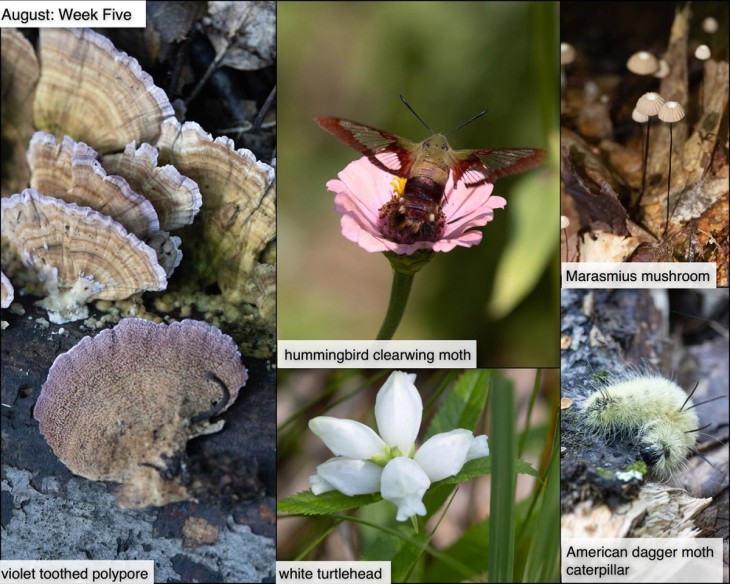This week in the woods, we found an especially pretty cluster of violet toothed polypore. This is a common bracket fungus distinguished by its purple edging and purple, porous underside (a.k.a. no gills), which varies from light purple to more of a dark eggplant hue. As with many other fungi, its color tends to fade with age. It typically grows in overlapping rows on dead wood.
On a quick trip to the mid-Atlantic, we had the opportunity to photograph a day-flying species of sphinx moth that we often see nectaring on flowers in Vermont, but which rarely stays still long enough to permit photographs. Turns out, all we needed was a patch of zinnias. The hummingbird clearwing moth (Hemaris thysbe) lives up to its name, with partially clear wings, and a hovering, buzzy way of flying that resembles that of the bird. Its caterpillars feed on a number of native plants, including viburnums, although we’ve also seen them feeding on invasive honeysuckle. The snowberry clearwing (Hemaris diffinis), a related and similar-looking species, is also present in our region, although we see it less frequently. A quick way to spot the difference (and it needs to be quick, as neither species is likely to stay still for inspection) is that hummingbird clearwings have rust coloring on their wings and bodies and are typically olive colored. Snowberry clearwings are typically more black and yellow, with a black bandit mask over their eyes.
With so many mushrooms crowding the forest floor this year, it’s easy to overlook the tiny ones – although on closer inspection, they’re often some of the most beautiful specimens. Among these are Marasmius capillaris and M. rotula – both featuring improbably long, dark stems and indented, grooved caps. Both typically grow in clusters. Our guess is that the mushrooms in the photo are M. capillaris, because they’re growing out of oak leaves, as this species is known to do.
American dagger moth caterpillars are crawling down from their trees as they – in common with so many other late summer caterpillars – finish feeding on leaves and prepare to spin cocoons in sheltered spots on the forest floor. The attractive caterpillars vary from lemon colored to white. They have plush toy looks, but watch out: those long setae (the black, spiky bristles) are defensive structures that can cause a painful skin reaction. American daggers feed on the leaves of a variety of hardwood trees, including oaks, maples, willows and birches. In spring, they’ll emerge as gray moths.
Finally, if you’re out on the edge of a wetlands this week, keep an eye out for white turtlehead, which despite its name can sometimes have a pinkish hue. As naturalist and author Mary Holland shows in this wonderful photo, the elongated, closed blossoms of these wildflowers require pollinators to have both strength and reach; long-tongued bumblebees are common visitors, although some insects may bite through the side of a flower to access the nectar.
What have you noticed in the woods this week? Submit a recent photo for possible inclusion in our monthly online Reader Photo Gallery.


